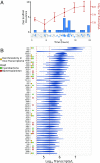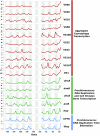Diel cycling and long-term persistence of viruses in the ocean's euphotic zone
- PMID: 29073070
- PMCID: PMC5663388
- DOI: 10.1073/pnas.1714821114
Diel cycling and long-term persistence of viruses in the ocean's euphotic zone
Abstract
Viruses are fundamental components of marine microbial communities that significantly influence oceanic productivity, biogeochemistry, and ecosystem processes. Despite their importance, the temporal activities and dynamics of viral assemblages in natural settings remain largely unexplored. Here we report the transcriptional activities and variability of dominant dsDNA viruses in the open ocean's euphotic zone over daily and seasonal timescales. While dsDNA viruses exhibited some fluctuation in abundance in both cellular and viral size fractions, the viral assemblage was remarkably stable, with the most abundant viral types persisting over many days. More extended time series indicated that long-term persistence (>1 y) was the rule for most dsDNA viruses observed, suggesting that both core viral genomes as well as viral community structure were conserved over interannual periods. Viral gene transcription in host cell assemblages revealed diel cycling among many different viral types. Most notably, an afternoon peak in cyanophage transcriptional activity coincided with a peak in Prochlorococcus DNA replication, indicating coordinated diurnal coupling of virus and host reproduction. In aggregate, our analyses suggested a tightly synchronized diel coupling of viral and cellular replication cycles in both photoautotrophic and heterotrophic bacterial hosts. A surprising consequence of these findings is that diel cycles in the ocean's photic zone appear to be universal organizing principles that shape ecosystem dynamics, ecological interactions, and biogeochemical cycling of both cellular and acellular community components.
Keywords: diel cycles; marine bacteriophage; marine virus; oligotrophic gyre; phage gene expression.
Copyright © 2017 the Author(s). Published by PNAS.
Conflict of interest statement
The authors declare no conflict of interest.
Figures



References
-
- Suttle CA. Viruses in the sea. Nature. 2005;437:356–361. - PubMed
-
- Rohwer F, Thurber RV. Viruses manipulate the marine environment. Nature. 2009;459:207–212. - PubMed
-
- Breitbart M. Marine viruses: Truth or dare. Annu Rev Mar Sci. 2012;4:425–448. - PubMed
-
- Sharon I, Banfield JF. Microbiology. Genomes from metagenomics. Science. 2013;342:1057–1058. - PubMed
Publication types
MeSH terms
Substances
LinkOut - more resources
Full Text Sources
Other Literature Sources

